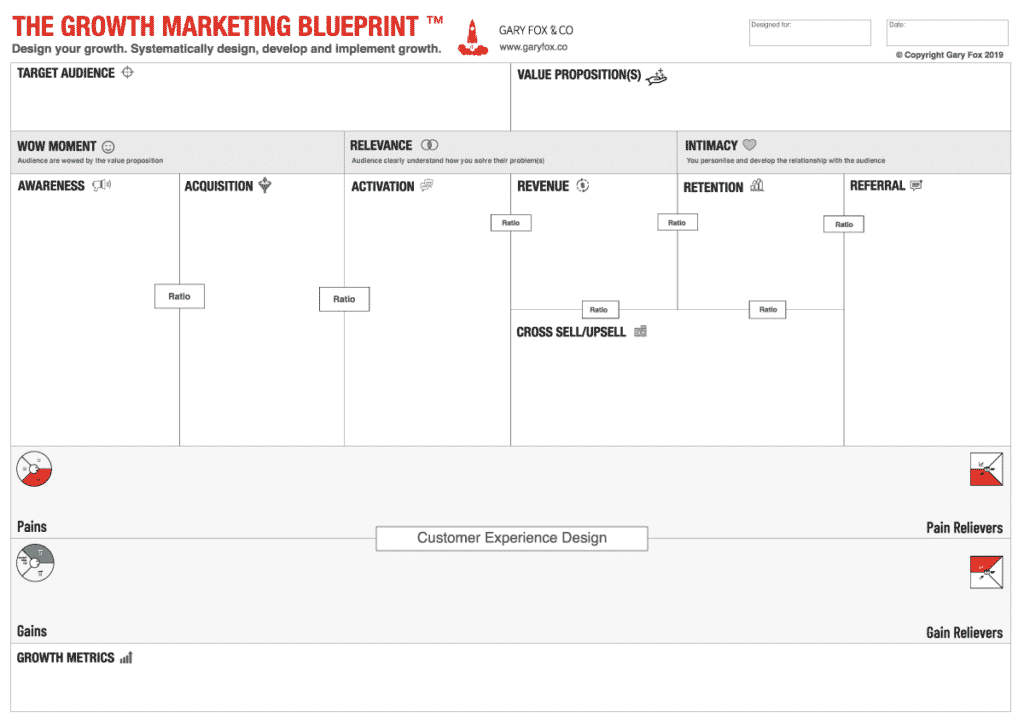In this guide, I will take you through the Growth Marketing Blueprint and how to use this canvas. I want you to learn how to use design thinking to transform how you plan for growth.
Table of Contents
THE GROWTH MARKETING BLUEPRINT SECTIONS
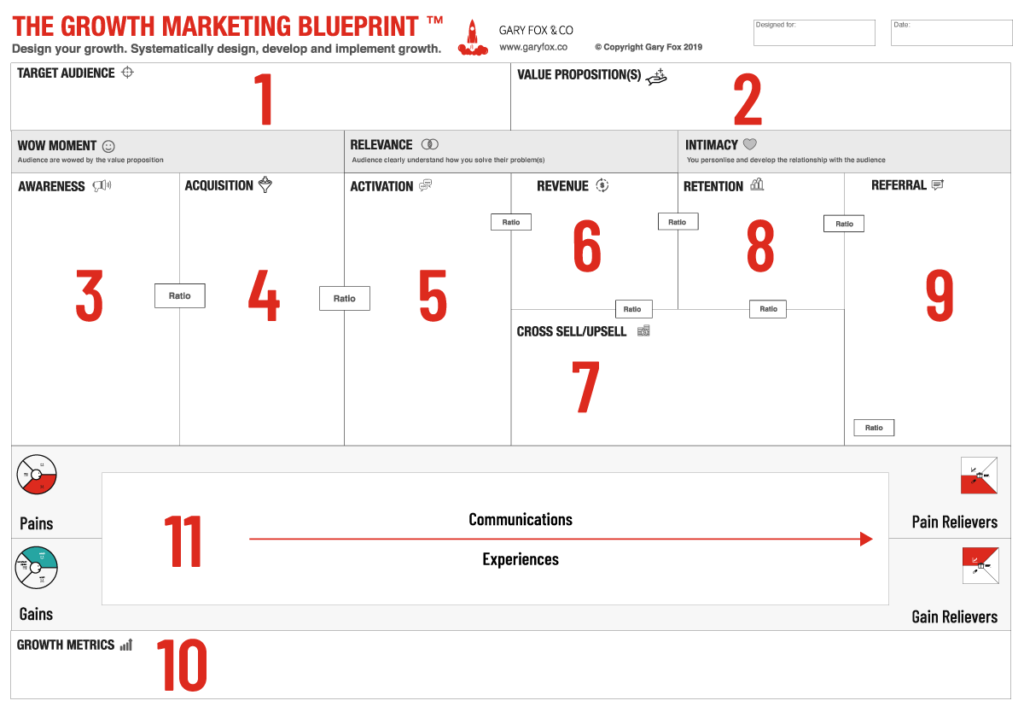
The following elements provide an overview of the main sections:
- Customer Segments: Who are the customers? What do they think? See? Feel? Do?
- Value Propositions: What’s compelling about the proposition? Why do customers buy, use?
- Customer Experiences: How do you want the customer to feel about your brand? What is the customer journey you want to design? What will be the most important touchpoints?
- Awareness: What will wow your customer? What first impression and experience can you design to captivate them? How will you deliver this? What channel and what media will you use?
- Acquisition: What value and triggers will you use to acquire customers? What value will you offer? What will be their first experience after you acquire them?
- Activation: How will you build trust? How do you get your customers to try your product or service, commit to a phone sales call, tell you what they need… This is when a customer moves from being a passive email to actively enquiring, trying a product or downloading more detailed information.
- Conversion (Revenue): How will they buy? How do you lower the barriers to make it easy to convert? How will you upsell or cross-sell at the point of conversion?
- Retention: How do you continue to build the relationship? What value do you offer to move away from being purely transactional? What does this mean for potential services or new products
- Referral: What are the business major cost drivers? How are they linked to revenue?
- Growth Metrics: What are your metrics that determine true growth e.g. Customer lifetime value,(CLV), churn rate, customer retention rate, cost per acquisition…
9. A STEP BY STEP GUIDE TO THE GROWTH MARKETING BLUEPRINT
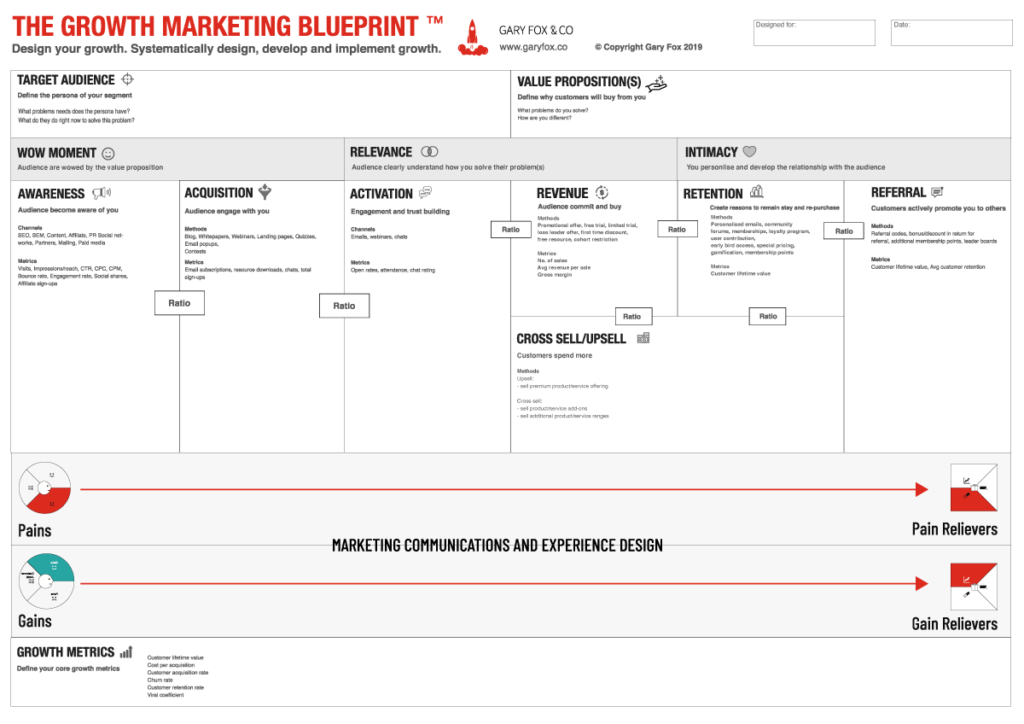
QUICK JUMP MENU
SECTION 1. TARGET AUDIENCE
STEP 1. SEGMENT AUDIENCE
This sounds obvious, but when you get into the detail many people overly simply the customer and don’t create a clear picture of who they are. As a result, the tendency is to make generalizations
Understanding who you are aiming your business at is critical to success.
I will be releasing a Persona Canvas shortly with some advice about how to use it. I’ve used my own version for a while.
It covers the main jobs to be done, pains and gains…but it also has some extra areas that make a huge difference in the outcome of how you think about your customers – more to come soon.
STEP 2. SEGMENT COMPOSITION
A Segment is the maco level of a potential customer base. Understanding the composition of the customers – how they vary, how many are there in different sub-segments helps you to determine the market potential and viability.
The traditional way of looking and understanding these sub-segments is to use Marketing Personas. This is where you should be able to visualize the people that are actually going to buy your product and how. It is the detail and depth of understanding here that counts. We are talking here about observations not just theory or statistics cleaned from a marketing report.
You need to understand what they think, see, feel, and do in your product area. Be sure to list both buyers and users of your product (many Personas will be both).
STEP 3. UNDERSTAND CUSTOMER PROBLEMS, NEEDS AND BEHAVIOURS
Many customers have hidden needs. In other words when you watch and observe them trying to do things they have to do workarounds or take a long route to accomplish their task. Understanding what customers are trying to achieve and observing how they achieve things provides valuable insights into why and how you can help them
SECTION 1. OUTCOME
Outcome: A clear and well-defined persona or persona(s) for each segment.
SECTION 2. VALUE PROPOSITION
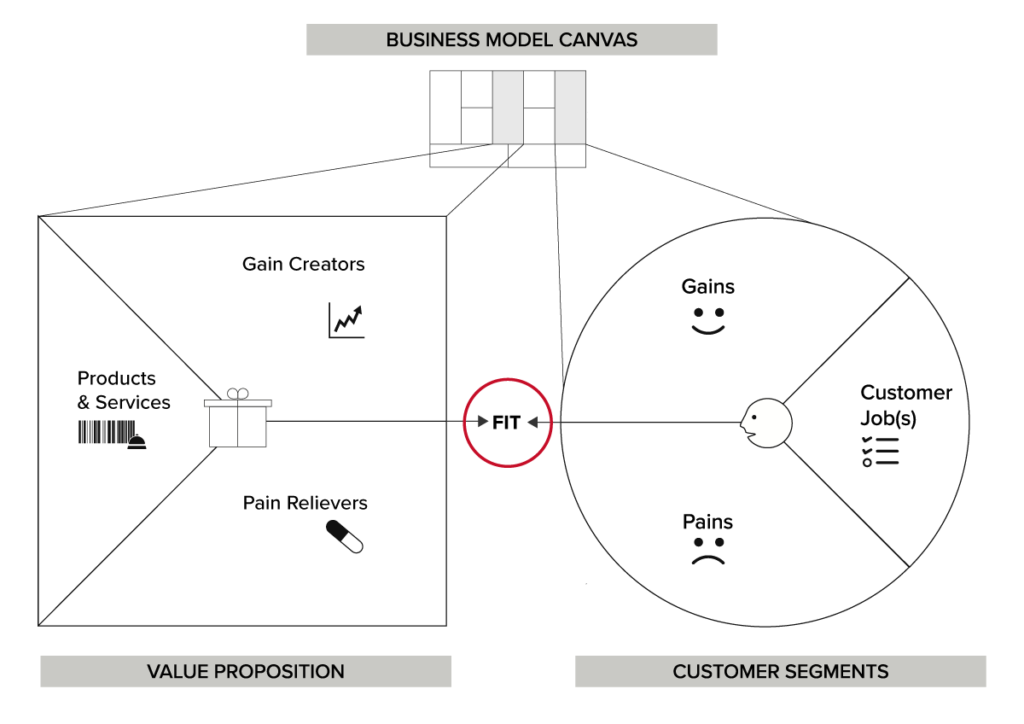
The Problems or Needs that you identified earlier and used to build your Marketing Personas now come into play.
STEP 1. USE THE VALUE PROPOSITION CANVAS
The Value Proposition Canvas describes the details of how the value proposition and customer segments interact.
In its simplest terms, a value proposition is a positioning statement that explains what benefits you provide for who and how you do it uniquely well. It describes your target customer, the pain point you solve, and why you’re distinctly better than the alternatives.
It means seem a bit odd asking this but there are many different dimensions to value? Equally, there are often hidden barriers people do not see the value the same as you?
What is important at this stage to challenge yourself your Value Propositions and why does your customer might prefer them to their Current Alternatives?
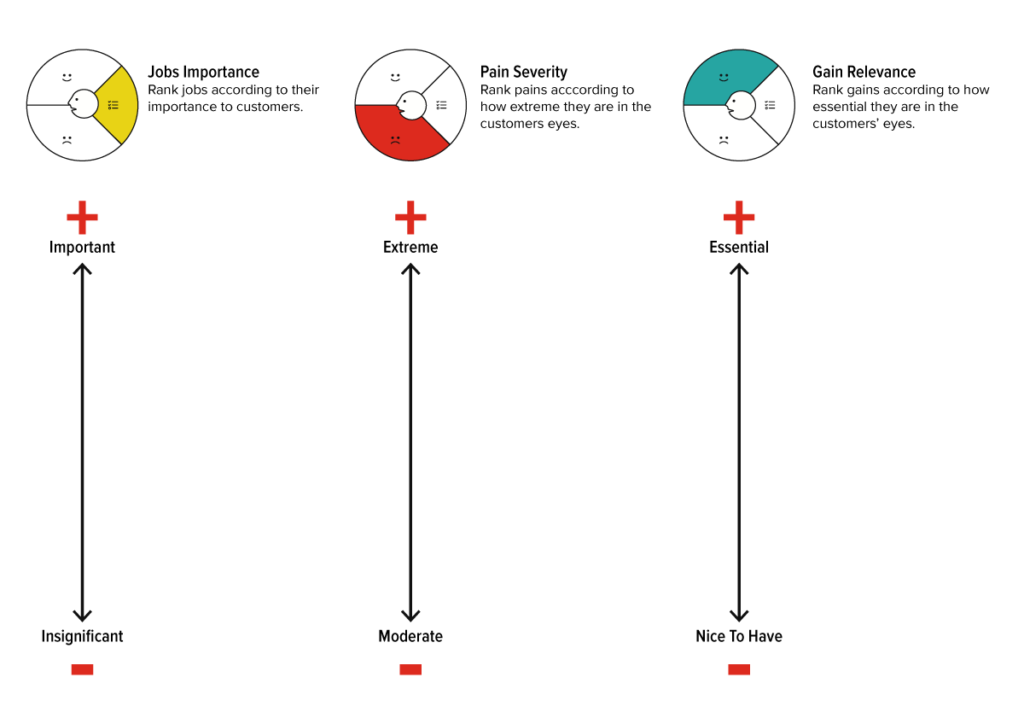
STEP 2. IDENTIFY oNE VALUE PROPOSITIONS FOR EACH CUSTOMER SEGMENT
Quite often you will have multiple value propositions. They are not the same benefits. Remember that value propositions are the sum of benefits you offer. A value proposition clearly aims at defining how it solves a problem and presents a new way of doing it compared to existing solutions.
Use a whiteboard or index cars for each value proposition. What things can you do that actually will make the biggest difference to the customer and be unique and better than the competition?
SECTION 2. OUTCOME
You should now have a clear link between value propositions and your personas. The value propositions should clearly tie in with the customer and why they will buy
SECTION 4. AWARENESS.
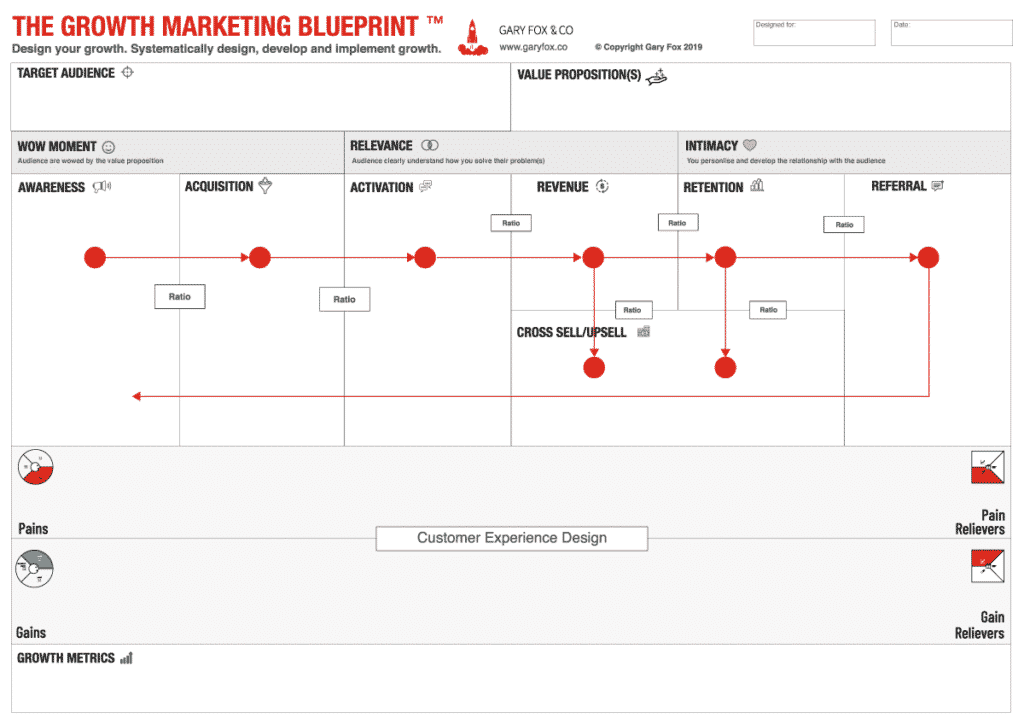
In the following sections, you will need to translate your design into how you deliver that experience. As an example, in awareness section how and what media and message can create a wow factor? How does that relate to their pains?
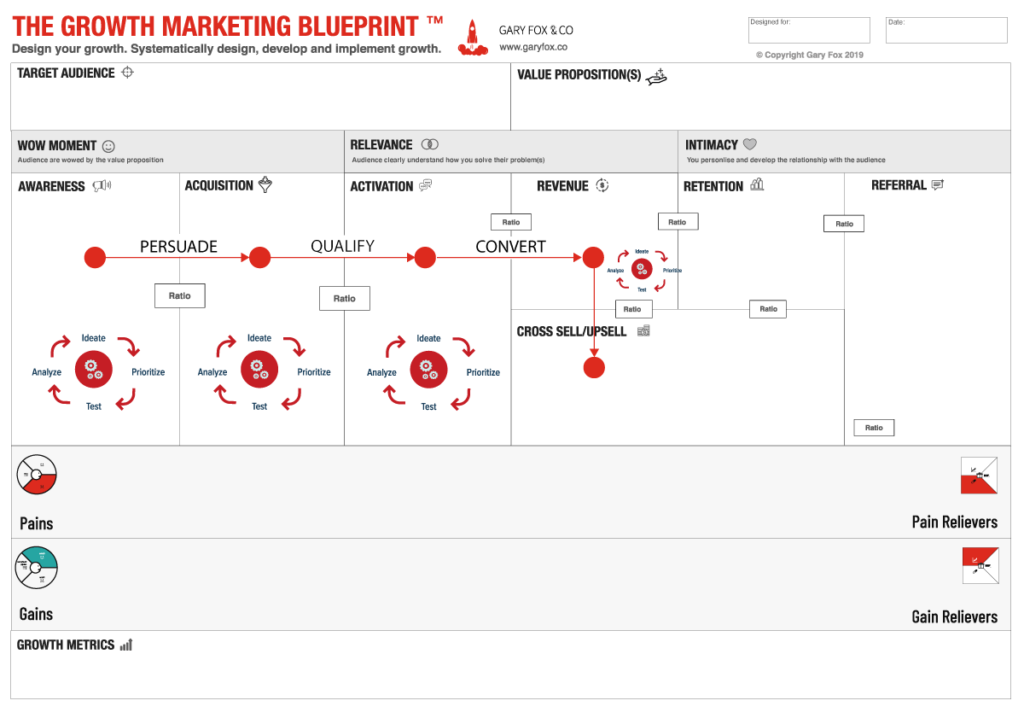
You are competing in a hectic and busy world where customers receive thousands of media impressions across all channels. Standing out now is hard. However, stories and narratives can quickly connect you to your customers.
What narrative can you use to create a wow moment? Is it big and bold or do you present redefine a view?
Awareness means cutting through normal and getting people to pay attention to. It requires you to be relevant to your audience but change what they expect to see or hear.
What you need to design is media and communications relevant to the channel. Spreading yourself too thin won’t work. You have limited resources and so focus counts.
Testing Ads, testing audiences and rapidly honing in on the best results is critical You are burning through money at this stage.
SECTION 4. OUTCOME
First of all have a clear goal, objectives, and targets. If you already have campaigns then you will have a benchmark of where you are now and what needs improving. As an output for planning, you need to have a clear focus on what channels fit with your segments, and what strategy you will use to deliver a wow moment.
Note: While you can chase clicks the goal is to balance relevance to customers that buy. Some businesses have huge dropout rates because they don’t create experiences and lack relevance. This can transform your results.
SECTION 5. ACQUISITION.
Email, push notifications and mobile are the main methods to acquire customers. You want to open up the lines of communication. Customers though need to trust you and to also have value.
What you produce here is critical and the methods you use. Optimizing every aspect of the acquisition is critical.
Linking the messages from your ads directly to your landing pages and communications is vital to keep alignment and relevance with your customers.
The second element in this process is to use the right tools so that you can quickly create and cycle through tests.
Outcome: Clear paths from Awareness to Acquisition with methods for acquiring customers.
SECTION 6. ACTIVATION.
Activation is the filtering and funnelling stage. Acquisitions can be done by offering people high-value downloads. However, if these are too broad then often then draw in the wrong audience and hence change the ratios. Conversely, if you target too broad an audience in the awareness stage you can bring in potential customers that aren’t a fit for your product.
Activation is a way to further extend your understanding of the potential customer. It is also a filter to determine who is ready to buy.
Note the buying pyramid here. At the top of the pyramid are potential customers that will buy soon, the next level is potential customers that will buy later, the third layer is ‘non-customers’ that will never buy but may refer and last of all, ‘non-customers’ people that will never buy or refer.
Part of the ongoing process in your database is to filter and understand the ratios you have.
At this stage, you need to develop your funnels to build trust and carry your customers on the journey. Using a narrative and storytelling process here is useful. Did you know we are more likely to buy when there is storytelling involved in the narrative? Psychological research on storytelling and persuasion demonstrates that stories lead to more persuasive messages.
Outcome: Mapped paths with clear conversion points built-in. Resources and other elements of trust that help to guide the decision-making process. Consistent experience design built-in so that relevance is maintained.
Note: Some people move faster than others. Enabling people to move faster through the funnel accelerates the process for them. Allow people to move at their own speed. Have you noticed this trend?
SECTION 7. CONVERSION AND CROSS-SELL/UPSELL (REVENUE)
Conversion points are where you invite a customer to buy. While you can take people to landing pages you can also directly take them to carts with products already loaded and a simplified checkout process. Doing this will depend on how well you have activated the potential customer and what value you offer to trigger them to buy. Other services and products within your portfolio can be brought into play. Remember a key driver for growth is to upsell or cross-sell.
Outcome: Planned conversion points. Analysis tool set up to optimize the conversion point. A clear strategy to upsell and cross-sell at the point of purchase.
SECTION 8. RETENTION.
Your customers are your greatest asset. Often I find that marketing departments have a ‘phew’ moment. They feel like getting customers over the line is where it ends. Of course, they want customers to enjoy the product or service but they’ve done their job.
STEP 1. MATCH VALUE TO EXPERIENCES
A massive amount of time goes into setting up the front engine of marketing. the ads, funnels, content production…imagine if you put the same amount of thought and time into developing the strategies and systems to retaining customers and getting referrals. How would your results change? What services or products can offer value here? What content?
STEP 2. EXTEND THE CUSTOMER EXPERIENCE
Retaining customers means making it easy for them to understand your products – that is a given. There is a range of options here – build user communities, offer educational programs, events e.g. Harley-Davidson…
STEP 3. ANALYSE DATA
The main focus has been to get potential customers to conversion. Now though you have the opportunity to really get into fine detail about who purchased. First of all, you want to profile your customers and validate your original segments and personas. Are they actually the same, are there differences, what new data can help you to know their pains better. What else could you do with this knowledge?
Getting deep with your customers reinforces the growth loop. This is how you can refine the front-end of your marketing to improve growth.
Furthermore, your customers provide an incredible opportunity to innovate. You can co-create new products and services with them.
SECTION 8. OUTCOME
Defined customer retention experiences. A strategy that fits with your market, product, and customer. Communications that extend the relationship. Data insights that inform your original personas and refine your awareness and acquisition processes.
Note: Data insights needn’t be hard to obtain. If you want to know some ways that can help you contact me via the Now Go Innovate Facebook group.
SECTION 9. REFERRAL.
POINT 1. WHY REFERRALS MATTER
Customers that recommend you to others are more likely to convert than cold potential customers through ads.
Referrals form a reinforcing feedback loop to the Awareness stage of the full funnel. This creates a compound effect.
The more customers you get the more referrals you get, which in turn generates even more referrals.
POINT 2. WHO REFERS?
Direct referrals are concerned with triggering customers to generate referrals. Some SaaS platform businesses use affiliate schemes to recruit affiliates, but this is not the same as your customers. Affiliates will generate content and refer based on a commission for a sale. While beneficial it is not the same as genuine referrals by customers.
The ideal scenario is that you want all of your customers to refer. However, there are many reasons why customers don’t refer even if they are wildly in love with your product. Most of the reasons are related to social psychology. If you want to read some articles on this email me.
What you want to do is incentivize the customers who have a referrer profile and then trigger them to refer. Use the tools and techniques that I outline in my program to identify and then trigger referrers.
SECTION 9. OUTCOME
Segmented customers profiles in your database based on a referer profile. A plan to activate referrals and then track metrics.
SECTION 10. GROWTH METRICS
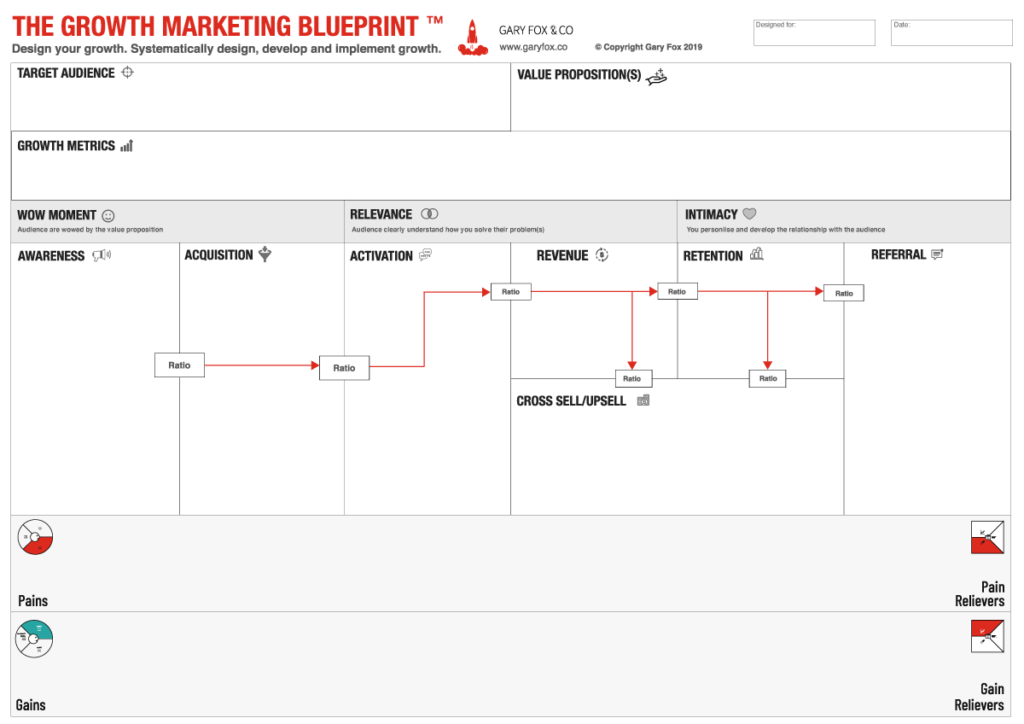
The final stage is to determine which matters will relate to your growth. Of course, track other measures, you can generate dashboards for that. I recommend tools like Cyfe to help integrate and manage most of the routine metrics.
Growth metrics are based on the main growth levers:
- Customer lifetime value
- Churn rate
- Cost per acquisition
- Customer acquisition rate
- Average sale/profit per customer
- Referral rate
- Viral coefficient
SECTION 10. OUTCOME
Link your measures to your marketing system to make it quick and easy to access your metrics.
SECTION 11. DESIGN COMMUNICATIONS AND EXPERIENCES
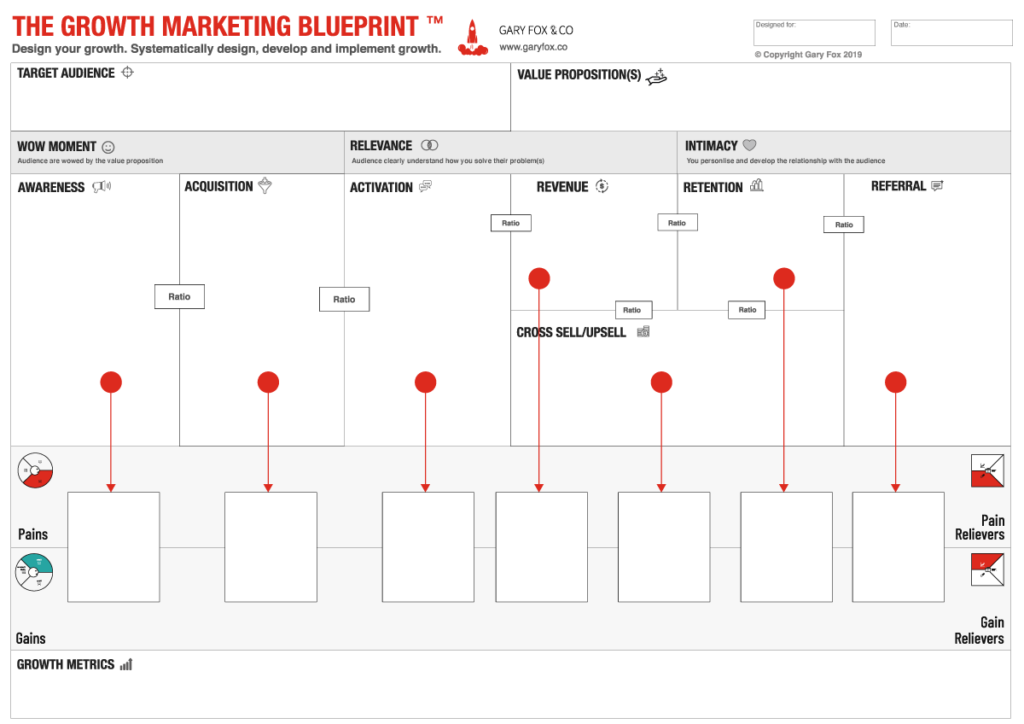
When you design marketing communications that are persuasive you need to:
- demonstrate empathy with your customer segment.
- use their pains to trigger emotional responses and influence them.
- harness gains to influence why and how a solution fits.
- use your prioritized pain relievers and gain creator to influence a call to action.
The work you have already done now needs to be mapped to the different stages of the funnel and woven into the experiences.
STEP 1. IDENTIFY MOMENTS OF TRUTH
If your not familiar with brand experiences don’t worry. The easy way to think about this is to as a customer journey. Along that journey, some moments are going to be more important than others. As an example, imagine you have flown to a holiday destination and your excited because you heard great reviews about the hotel you are staying in.
When you get there the concierge looks like he is busy with paperwork. He sees you but ignores you looking like he wants to finish his paperwork first before attending to you. After several minutes, he looks up only to talk to a passing waiter.
Fast forward to the room and you are shown to a room that has no view, it is next to the elevator and added to that you can see that the room looks like it needs a serious clean.
I’ve exaggerated these moments.
We can in our minds replay them, build your own narrative and how you would want to change that whole experience. Each brand and business is positioned differently in the market. How you design and create the moments and experiences will be unique to you.
Needless to say, that you are competing in a market where customers have choices. Making each experience count is important. Experiences are part of how you deliver value. Compounded they create the overall brand experience.
You have the opportunity to create moments that wow customers. You have the opportunity to be relevant to your customers and personalize the communications to each segment. These are the moments of truth that form long-lasting impressions.
STEP 2. DESIGN THE EXPERIENCES YOU WANT TO DELIVER
Design your experiences recognizing that some have a far greater impact than others. You need to understand what a customer is trying to do, what information they are looking for at each stage. These are moments that when you understand them, you can then add value and help your customer.
In the following sections, you will need to translate your design into how you deliver that experience. As an example, in awareness section how and what media and message can create a wow factor? How does that relate to their pains?
STEP 3. MAP THE MOMENTS TO INFLUENCE
As well as understanding what value you can offer, you need to plan how and when to influence your customer. What stage and point do you want to get them to take an action, what is that action? how will you persuade them? By designing these moments you will improve your conversions.
SECTION 3. OUTCOME
You want to focus on moments that matter for each section maximum. In some situations, you can reduce that further. The art of this is to move away from thinking about systems and technology and think about what you want people to feel, see and do. You will understand when you want to influence your customer and how you intend to do it.
Experiences are there to take the customer on a journey to buy your product. That means you plan conversions points.
You control the journey.
In essence, it means you are trying to shorten the journey and optimise it so it is effective for you and the customer.
You do this by building trust, providing the right information at the most relevant time and then influencing the customer to move forward and convert to the next stage.
Remember, your goal is to filter out people that are unlikely to buy or are the wrong fit.
NEXT STEPS IN USING THE GROWTH MARKETING BLUEPRINT
Core Applications
The most core and obvious applications of the Growth Marketing Canvas are to ask:
- What metrics do I have now?
- Where are my current bottlenecks?
- What needs fixing first?
- What marketing stack/system can I use to integrate and implement the stages?
- What experiences do I change first (note relate these to your bottleneck?
- Rinse and repeat at least quarterly?
Competitiveness
The canvas does a good job of helping you figure out your marketing. Use it to understand how you can transform from focus from the front-end of the funnel to growth-focused full-funnel approach. Don’t forget to analyse competitors and set a clear competitive strategy based on differentiating and improving the customer experience vs. your competition.
Next Steps
Every business is a work in progress. As you go through the canvas, you may encounter areas that give you trouble. If you need help get in touch.
SUBSCRIBE NOW
Get more updates and free resources by joining the newsletter.
